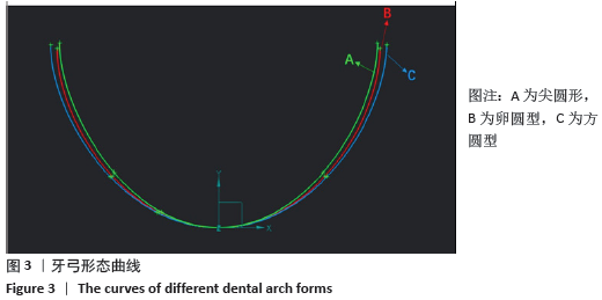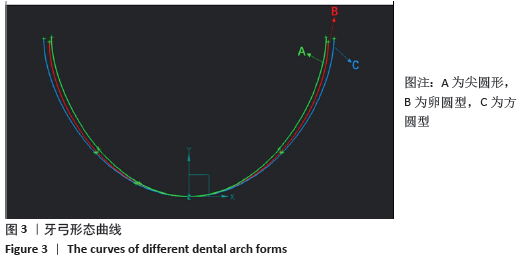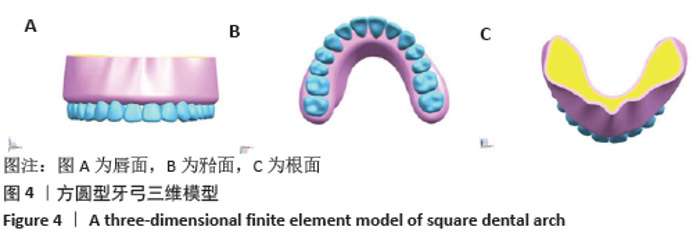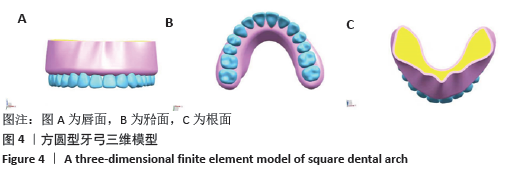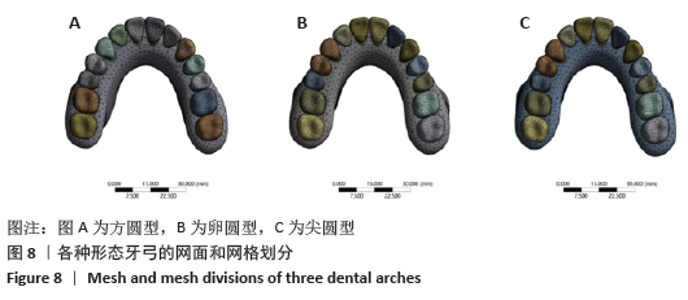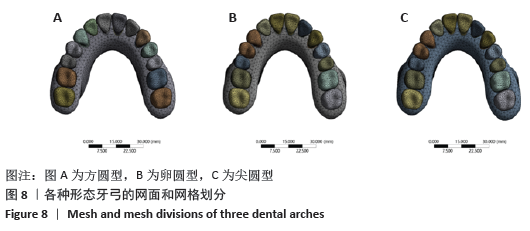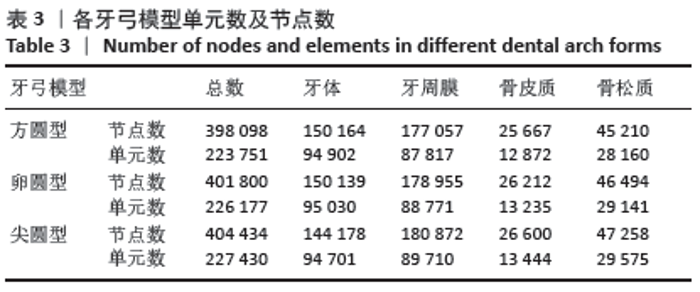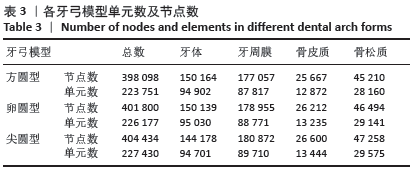[1] 皮昕.口腔解剖生理学[M]. 7版.北京:人民卫生出版社,2014:74-75.
[2] LEE KJ, TRANG VT, BAYOME M, et al. Comparison of mandibular arch forms of Korean and Vietnamese patients by using facial axis points on three-dimensional models. Korean J Orthod. 2013;43(6):288-293.
[3] 曹正飞,王青青,关慧娟,等.恒牙牙合早期安氏Ⅱ类2分类患者牙弓及基骨弓宽度的特征分析[J].中国医科大学学报,2020,49(1):35-38.
[4] SINGH JR, KAMBALYAL P, JAIN M, et al. Revolution in Orthodontics: Finite element analysis. J Int Soc Prev Community Dent. 2016;6(2):110-114.
[5] GUO HZ, ZHANG SC, GUO DQ, et al. Influence of cement-augmented pedicle screws with different volumes of polymethylmethacrylate in osteoporotic lumbar vertebrae over the adjacent segments: a 3D finite element analysis. BMC Musculoskelet Disord. 2020;21(1):460.
[6] READIOFF R, GERAGHTY B, COMERFORD E, et al. A full-field 3D Digital Image Correlation and Modelling Technique to Characterise Anterior Cruciate Ligament Mechanics ex vivo. Acta Biomater. 2020;S1742-7061(20)30379-2.
[7] 陈昭慧. 三维有限元在微创牙髓治疗研究中的应用进展[J].临床口腔医学杂志,2019,35(5):316-318.
[8] 苏涛,王星星,向彪,等.不同刚度的无托槽隐形矫治器扩大上颌牙弓的有限元分析[J]. 口腔医学研究,2020,36(5):454-458.
[9] SGHAIREEN MG, ALBHIRAN HM, ALZOUBI IA, et al. Intraoral versus extraoral measurement of the height of the interproximal contact area in maxillary anterior teeth. Med Princ Pract. 2015;24(2):136-141.
[10] KIM BI, BAYOME M, KIM Y, et al. Comparison of overjet among 3 arch types in normal occlusion. Am J Orthod Dentofacial Orthop. 2011; 139(3):e253-e260.
[11] ALHARBI S, ALKOFIDE EA, ALMADI A. Application of the cubic spline function in the description of denta. Angle Orthod. 2008;78(2):281-287.
[12] MINA M, BORZABADI-FARAHANI A, TEHRANCHI A, et al. “Mathematical beta function formulation for maxillary arch form prediction in normal occlusion population.” Odontology. 2017;105(2):229-236.
[13] 郝俊玲. 基于基骨的个性化下颌牙弓形态研究[D].福州:福建医科大学,2018.
[14] 杨安,刘菁,方早,等.基于三维视觉测量的上颌牙弓形态分类要素分析[J].口腔医学研究,2014,30(2):155-158.
[15] 王璇,谢小瑞,李琴,等.正常牙合垂直骨面型与牙弓宽度的相关性研究[J].实用口腔医学杂志,2017,33(6):802-806.
[16] 王鹏,李大军,刘建彰.上颌前牙宽度、前牙弓周长与前牙弓深度的相关性研究[J].北京大学学报(医学版),2020,52(1):124-128.
[17] 曹正飞,王青青,关慧娟,等.恒牙牙合早期安氏Ⅱ类2分类患者牙弓及基骨弓宽度的特征分析[J].中国医科大学学报,2020,49(1):35-38.
[18] 盛丽,李桃,吾尔肯•卡满别克,等.混合牙列期下前牙拥挤与牙弓、基骨弓相关性研究[J].口腔医学研究,2019,35(11):1057-1061.
[19] 李毕超,高瑜,武姗,等.滑动法关间隙过程中横腭杆对上牙弓宽度的影响:三维有限元研究[J].实用口腔医学杂志,2019,35(5):691-695.
[20] 李贺,卢璐,郭泾.利用三维数字模型对16名大学生个别正常泾下颌牙弓及基骨形态的测量比较[J].山东大学学报(医学版),2019, 57(7):108-113.
[21] 贺泽群,曾欢,唐欢,等.替牙列期儿童错颌畸形颅-颌骨及牙弓的测量分析[J].重庆医科大学学报,2018,43(10):1354-1359.
[22] FERRARIO VF, SFORZA C, MIANI A JR, et al.Mathematical definition of the shape of dental arches in human permanent healthy dentitions. Eur J Orthod. 1994;16(4):287-294.
[23] SGHAIREEN MG, AL-ZAREA BK, AL-SHORMAN HM, et al. Clinical measurement of the height of the interproximal contact area in maxillary anterior teeth. Int J Health Sci (Qassim). 2013;7(3):325-330.
[24] SHIMOMURA N, TANAKA R, SHIBATA Y, et al. Exceptional contact elasticity of human enamel in nanoindentation test. Dent Mater. 2019; 35(1):87-97.
[25] 边媛媛,厉松.邻面牙釉质厚度及相关规律的研究进展[J].北京口腔医学,2017,25(3):178-180.
[26] 侯沐明. 个别正常牙合邻面接触区的定量研究[D].广州:广州医科大学,2017.
[27] LIU Z, SUN T, FAN Y. Biomechanical influence of anchorages on orthodontic space closing mechanics by sliding method. Med Biol Eng Comput. 2020;58(5):1091-1097.
[28] PARK KH, BAYOME M, PARK JH, et al. New classification of lingual arch form in normal occlusion using three dimensional virtual models. Korean J Orthod. 2015;45(2):74-81.
[29] BEGOLE EA, LYEW RC. A new method for analyzing change in dental arch form. Am J Orthod Dentofacial Orthop. 1998;113:394-401.
[30] BRAUN S, HNAT WP, FENDER DE, et al. The form of the human dental arch. Angle Orthod. 1998;68:29-36.
[31] MINA M, BORZABADI-FARAHANI A, TEHRANCHI A, et al. Mathematical beta function formulation for maxillary arch form prediction in normal occlusion population. Odontology. 2017;105(2):229-236.
[32] WELLENS H. Applicability of mathematical curve-fitting procedures to late mixed dentition patients with crowding: a clinical-experimental evaluation. Am J Orthod Dentofacial Orthop. 2007;131: 160.e17-25.
[33] ALHARBI S, ALKOFIDE EA, ALMADI A.Mathematical analyses of dental arch curvature in normal occlusion. Angle Orthod. 2008;78(2):281-287. |
